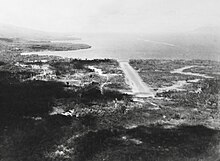
Kutini-Payamu is a National Park located in Queensland, Australia, 1,940 kilometres (1,210 mi) northwest of Brisbane and 100 kilometres (62 mi) east of Weipa in the Cape York Peninsula, Queensland. Within the National Park is the Iron Range, Scrubby Creek mining site and the Aboriginal Shire of Lockhart River. During World War II several Australian Army units were stationed in the area.

The Battle of Milne Bay, also known as Operation RE or the Battle of Rabi (ラビの戦い) by the Japanese, was a battle of the Pacific campaign of World War II. Japanese marines, known as Kaigun Tokubetsu Rikusentai, with two small tanks attacked the Allied airfields at Milne Bay that had been established on the eastern tip of New Guinea. Due to poor intelligence work, the Japanese miscalculated the size of the predominantly Australian garrison and, believing that the airfields were defended by only two or three companies, initially landed a force roughly equivalent in size to one battalion on 25 August 1942. The Allies, forewarned by intelligence from Ultra, had heavily reinforced the garrison.
Operation Husky order of battle is a listing of the significant military and air force units that were involved in the campaign for Sicily, July 10 – August 17, 1943.

RAAF Base Townsville is a Royal Australian Air Force (RAAF) air base located in Garbutt, 2 nautical miles west of Townsville in Queensland, Australia. It is the headquarters for No. 1 Wing Australian Air Force Cadets and, along with Lavarack Barracks, establishes Townsville as a key military centre. The base's airfield is shared with the Townsville Airport.
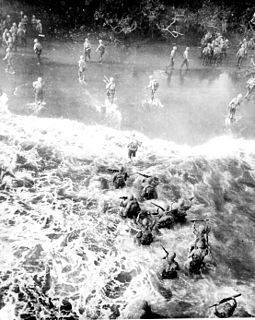
The Battle of Cape Gloucester was fought in the Pacific theater of World War II between Japanese and Allied forces on the island of New Britain, Territory of New Guinea, between 26 December 1943 and 16 January 1944. Codenamed Operation Backhander, the US landing formed part of the wider Operation Cartwheel, the main Allied strategy in the South West Pacific Area and Pacific Ocean Areas during 1943–1944. It was the second landing the US 1st Marine Division had conducted during the war thus far, after Guadalcanal. The objective of the operation was to capture the two Japanese airfields near Cape Gloucester that were defended by elements of the Japanese 17th Division.

Royal Air Force Andrews Field or more simply RAF Andrews Field is a former Royal Air Force station located 4 miles (6.4 km) east-northeast of Great Dunmow Essex, England.

This is the complete order of battle of Allied and Japanese forces during the Borneo campaign of 1945. As the campaign was fought in three geographically separate areas and the same air and naval units supported more than one of these battles the order of battle is split into the three areas.
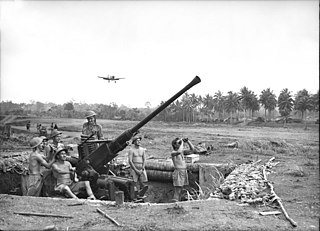
Gurney Airport is an airport serving Alotau in the Milne Bay Province of Papua New Guinea (PNG).

Merauke Force was an Australian-led military force of World War II which was responsible for defending Merauke in Dutch New Guinea from Japanese attack amidst the Pacific War. The force was established in late 1942 and was disbanded at the end of the war, having never seen combat. The Japanese attack did not eventuate and from mid-1944 the force was progressively drawn down and its assigned units redeployed to Australia or elsewhere in the Pacific. At its height, Merauke Force included troops from Australia, the Netherlands East Indies and the United States, as well as several squadrons of aircraft, including a joint Australian-Dutch fighter unit.

Fenton Airfield was a World War II military airfield in the Northern Territory of Australia located at Tipperary Station in what is now the locality of Douglas-Daly and named after flight lieutenant Clyde Fenton.
Livingstone Airfield was an airfield at what is now Livingstone, Northern Territory, Australia during World War II.
Bohle River Aerodrome was an aerodrome located 12.66 km (7.87 mi) west of Townsville, Queensland, Australia.

Breddan Aerodrome is a heritage-listed abandoned aerodrome at Gregory Developmental Road, Breddan, Charters Towers Region, Queensland, Australia. It is located 15 kilometres (9.3 mi) north of Charters Towers. It was built from 1942 to 1943 by Allied Works Council and Queensland Main Roads Commission. The airfield was constructed for the USAAF 38th Bomb Group in August 1942 as a satellite field for Charters Towers Airport, and later used by the Royal Australian Air Force (RAAF) during World War II as a maintenance base. Consisting of two runways, the airfield was abandoned after 1948. Today, the remains of the airfield consist of some deteriorating runways, taxiways and hardstands, mostly being reclaimed by grassland and shrub. No buildings have survived. It is also known as Breddan Airfield and Breddan WWII Aircraft Maintenance, Repair and Salvage Depot. It was added to the Queensland Heritage Register on 16 April 2010.
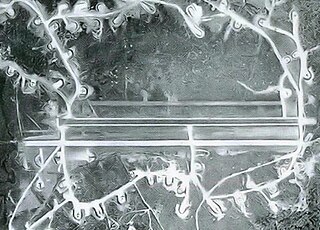
The Port Moresby Airfield Complex was a World War II military airfield complex, built near Port Moresby in the Territory of Papua and New Guinea. It was used during the Battle of New Guinea as a base of Allied air operations primarily in 1942 and early 1943. It later became a support base as the battle moved to the north and western part of New Guinea. It was closed and the facility turned over to civil authorities after the end of the war in September 1945.
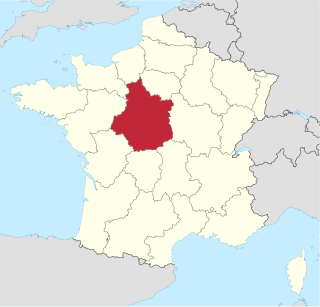
Chartres – Champhol Aerodrome is an airport serving Chartres and Champhol, in the Eure-et-Loir department in north-central France. The airport is located 2.5 km (1.3 NM) east-northeast of Chartres and it is southeast of Champhol. It supports general aviation with no commercial airline service scheduled.

The Battle of Goodenough Island, also known as Operation Drake, was a battle of the Pacific campaign of World War II. The Allies landed on Goodenough Island, Papua, and clashed with a Japanese Kaigun Rikusentai. The Japanese troops had been stranded on the island during the Battle of Milne Bay in late August 1942. "Drake Force", consisting of the Australian 2/12th Battalion and attachments, landed on the southern tip of Goodenough Island at Mud Bay and Taleba Bay on 22 October, tasked with denying the Japanese use of the island prior to the Buna campaign. Following a short but intense fight, the Japanese forces withdrew to Fergusson Island on 27 October. After the battle, Goodenough Island was developed into a major Allied base for operations later in the war.

Milne Force was a garrison Australian Army force formed in July 1942 during the World War II which controlled allied naval, land and air units in the region of Milne Bay, in the Territory of Papua. The force was responsible for constructing airstrips, roads, camps and defensive positions.

Peter St George Bruce Turnbull, DFC was an Australian fighter ace of World War II, credited with twelve aerial victories. Born in Armidale, New South Wales, he was an electrician before he joined the Royal Australian Air Force (RAAF) in January 1939. After pilot training he was posted to No. 3 Squadron, which departed for action in the Middle East in July 1940.

This is an order of battle listing the Japanese and Allied forces involved in the Battle of Milne Bay from 25 August – 7 September 1942.

Naval Base Milne Bay, also called Naval Advance Base Milne Bay, was new major United States Navy sea and airbase base built on Milne Bay in Milne Bay Province in south-eastern Papua New Guinea. By spring 1943, the build up of the US Navy to support the Pacific War had caused overcrowding at the ports on the east coast of Australia. To help the Seabee departed Brisbane on June 19, 1943 to set up a new base in Milne Bay. Naval Base Milne Bay headquarters was at Ladava Navy Base. The Royal Australian Navy already had a small base in Milne Bay: HMAS Ladava. Australians were able to defend and keep Milne Bay in the Battle of Milne Bay in 1942. Naval Base Milne Bay was built during World War II to support the many ships and aircraft fighting and patrolling in the South West Pacific theatre of war. Ladava Navy Base provided a large protective US Navy fleet anchorage at Gahora Bay next to Ladava. At Naval Base Milne Bay Seabee built large Naval facility.

